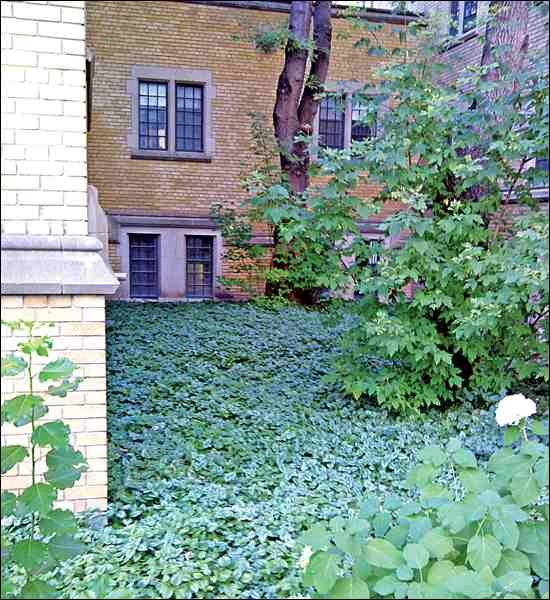Plants that are tough as nails and fill a space quickly are a boon to acreage owners with oceans of space. But in city yards with limited yardage, plants that aggressively expand their territory soon intermingle with and even choke out their neighbours and eventually invade the sacrosanct lawn. And most plants that fit this category are nealy impossible to eradicate by hoe or by chemical. However, when planted in the right location, they can be invaluable urban allies.
The "right"location is one that is bounded by hard surfaces on all sides - surfaces like concrete, pavement and sides of buildings. The hard surfaces prevent aggressive plants from capturing more valuable real estate by limiting their spread. These locations can be the narrow wasteland strips of ground between houses or adjacent driveways; between a house and a sidewalk; the narrow boulevard strip between a sidewalk and road; or in more commercial settings, non-irrigated parking lot beds. Sometimes these strips are planted to grass, but then the problem is keeping them well watered, fertilized, weed-free and mowed. If wide enough, small shrubs can be planted to fill in the space, but if neglected they do not serve their purpose for long. More often than not, these strips soon become bare soil or worse, a weed infested mess.
The solution is to take advantage of the same characteristics of aggressive plants that make them a problem elsewhere in the yard: rapid spread by either rhizomes (underground creeping stems) or stolons (aboveground creeping stems); drought tolerance; indifference to soil conditions; and high heat and cold tolerance. In other words, characteristics that allow these plants to survive and even thrive under neglect. The other benefit is that once established, they will even out compete weeds.
Care and keeping of established plantings is relatively straightforward. You can water during prolonged dry spells to make yourself feel better, but this is usually not necessary. Mow or use your string trimmer in late fall or early spring before new growth to cut down and remove old foliage. That's it.
Prairie-hardy perennials that fit this description include goutweed, ribbon grass, false lamium and lily-of-the-valley.
Variegated goutweed (Aegopodium podograria 'Variegatum', aka bishop's weed, snow-on-the-mountain) forms a dense mat of erect, light green and white leaves, 10 - 12 inches tall. In mid-summer, white umbels shoot up, overtopping the leaves by an additional 6 - 10 inches. A truly versatile plant, it grows in most light conditions from full sun to shade. Remove any non-variegated portions as these may eventually replace the variegated form.
Variegated ribbon grass (Phalaris arundinacea 'Picta') is a medium tall (1 - 3 feet), upright grass. It tolerates a wide variety of soil and moisture conditions and grows in full sun to shade.
Variegated false lamium (Lamiastrum galeobdolon 'Variegata'; aka yellow archangel) is a creeping groundcover, reaching 12 - 18 inches tall. Leaves are diamond-shaped with a silver-lace pattern overtop a dark green background. It grows best in part to full shade. Even moisture is preferred but will also tolerate dry conditions making it ideal for difficult dry shady areas under dense tree canopies or roof overhangs. Plants are covered with bright yellow flowers in early spring. 'Herman's Pride' is an upright, clump form that does not spread quickly.
Lily-of-the-valley (Convallaria majalis) is the one that many fool themselves into thinking that they can control in the garden. But too soon, it spreads beyond its allotted space. The glossy leaves are medium green. Fragrant, white flowers are an early season treat that can be used as cut flowers in spring bouquets. It is a diminutive plant, usually reaching only 6 - 10 inches tall. Moist part shade is best, but like false lamium, lily-of-the-valley grows fine in dry dense shade as well.




